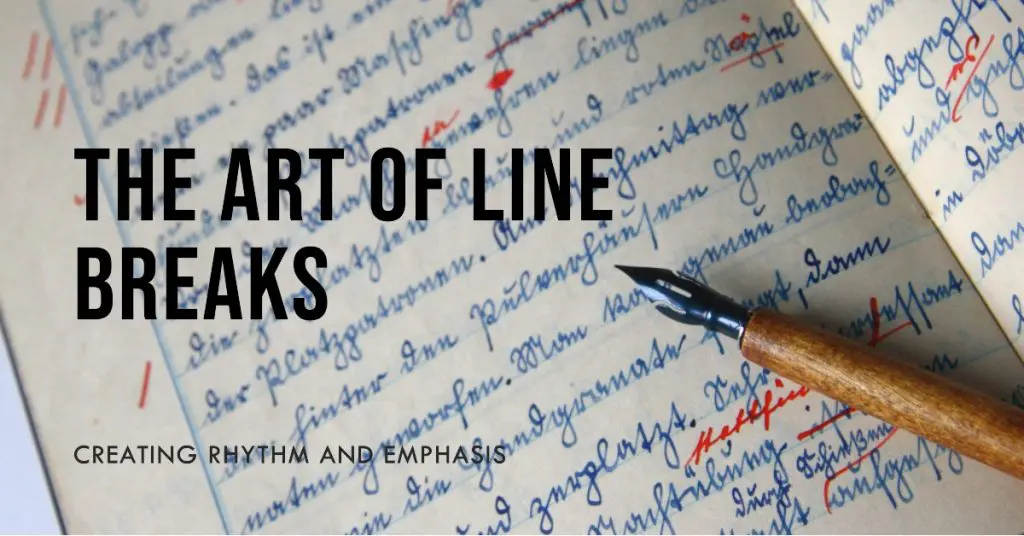Line Breaks in Poetry

Have you ever felt your poetry needs more punch it needs? Line breaks are the secret spice that can turn bland verses into powerful poetry.
This guide will show you how to use them to add depth and emotion to your work. Dive in, and let’s break lines like a pro!
Key Takeaways
- Line breaks can give poems more rhythm and emotion. They tell readers where to pause, add meaning, and help shape the poem.
- There are types of line breaks, like end-stopped lines with punctuation and enjambed lines that keep going. Caesuras give a break in the middle of a line.
- A poet can use experiments with line breaks for different effects. This includes making drawings with words or changing how fast we read the poem.
- To get better at using line breaks, you can try writing exercises. You can also learn by looking at famous poems.
- When poets know how to use line breaks well, they touch people’s hearts more deeply.
Table of Contents
Understanding Line Breaks in Poetry

Line breaks in poetry are the intentional placement of a line break, which determines how a poem is read and understood.
There are different types of line breaks that serve various functions in poetry, such as enjambed lines, end-stopped lines, half lines/caesuras, and experimental lines/visual poetry.
Definition and purpose of line breaks
A line break in poetry is a spot where one line ends and the next starts. Think of it like a door between lines, telling you when to move on.
This tool helps slice up poems so they only go on a short time across the page.
It also makes reading easier because your eyes can jump from one line to another quickly.
These breaks do more than divide text; they give words extra power by making us pause.
The stop we feel at each break adds weight and can change how we understand what’s being said.
Just like periods or commas tell us how to read prose, line breaks guide us through a poem, shaping its rhythm and sometimes even its meaning.
They’re like quiet drumbeats that help shape the music of poetry.
Different types of line breaks
Line breaks in poetry are potent tools. They can add rhythm, surprise, and emotion to your poems. Here are the types of line breaks you’ll often see:
- End-stopped lines
- Enjambed lines (also known as run-on lines)
- Caesuras
- Visual poetry or concrete poetry
The role of line breaks in poetry
Line breaks in poetry do a lot of work. They help create the shape and feel of a poem.
When you break a line, it can make a pause or highlight a meaningful word or idea. This adds to the rhythm of your poem.
Line breaks also set poetry apart from regular writing.
By playing with where to end lines, poets control how their poems are read. Sometimes, they make you stop and think before moving on to the following line.
Other times, they keep you reading without stopping so that many words flow together quickly.
Good poets use line breaks carefully to add meaning and emotion to their work.
Using Line Breaks Effectively

Mastering the use of enjambed lines, end-stopped lines, half lines/caesuras, and experimental lines/visual poetry is crucial for adequate line breaks in poetry.
Understanding how to use these different types of line breaks can significantly impact the flow and meaning of a poem.
Enjambed lines
Enjambment is when a sentence or phrase in poetry doesn’t stop at the end of a line but flows into the next.
It creates a sense of continuity and can carry one idea across multiple lines, adding fluidity and energy to the poem.
Enjambment gives poets more freedom to express their thoughts without being confined by traditional line breaks.
This intimate, subtly interrupted conversation between lines adds depth and complexity to free-verse poetry, as it allows for creative expression beyond the constraints of regular line breaks.
Poets often use enjambment with purpose and intention to create specific effects within their poems.
The continuation of thought from one line to the next adds rhythm and momentum, engaging readers in a seamless flow of words that enhances the overall impact of the poem on its audience.
End-stopped lines
An end-stopped line in poetry is a line that ends with punctuation, creating a natural pause.
This allows the reader to take a breath and absorb the meaning before moving on. Think of it like hitting the brakes at the end of a line – you come to a complete stop.
The renowned poet C.P. Cavafy often used end-stopped lines in his work, which added emphasis to each idea or image.
End-stopped lines are like traffic lights for your poem, signaling when to pause and reflect.
They provide clarity and structure, guiding the reader through the rhythm of your words.
Half lines/caesuras
When it comes to line breaks in poetry, we must recognize the half lines and caesuras.
A caesura is like a little pause within a line—just enough space to catch your breath before continuing. It adds a rhythm and emphasis that can really make your words sing.
The half line, marked by these caesuras, creates an intriguing tension in the middle of a line, drawing attention to that moment of pause or thought.
These breaks in rhythm or syntax are where poets can play with the flow of their words for added impact.
Experimental lines/visual poetry
Now, let’s explore the artistic realm of experimental lines and visual poetry.
Experimental line breaks in poetry can redefine the conventional structure, adding a new dimension to the way poems are presented on the page.
By creatively breaking lines and strategically positioning words, poets can evoke unique visual effects that enhance the overall artistic expression of their work.
Visual poetry heavily relies on this technique to create captivating and imaginative compositions, elevating poetry from mere words to visually striking pieces of art.
These experimental approaches provide poets with exciting opportunities to infuse their work with creativity and originality, captivating readers through an innovative presentation that complements the poem’s content.
In experimenting with line breaks for visual poetry, poets have a canvas where they can blend language and design elements to craft visually engaging pieces that transcend traditional poetic forms.
Functions of line breaks
When considering the functions of line breaks in poetry, it’s crucial to understand how they contribute to a poem’s overall structure and meaning.
Here are some key functions of line breaks to help you master their art:
- Guide the reader’s pace and rhythm, controlling how the poem is read and emphasizing specific words or phrases.
- Create visual impact and shape on the page, influencing the reader’s engagement with the poem.
- Control the flow and timing of information delivery, allowing for pauses or shifts in thought that add depth to the poem.
- Please contribute to the musicality and cadence of the poem, influencing its overall tone and emotional resonance.
- Enhance ambiguity or multiple meanings by strategically breaking lines at pivotal points, prompting readers to consider different interpretations.
Guidelines for Mastering Line Breaks in Poetry
Mastering line breaks in poetry requires careful consideration and technique.
This section will provide tips and techniques for effectively using line breaks to enhance meaning and impact in your poems.
It will also cover how to choose the right place for a line break and experiment with different types of line breaks.
Tips and techniques for effective line breaks
- Start a new line when there’s a new idea or speaker in the poem.
- Use line breaks judiciously to keep the flow of the poem smooth and not disrupted.
- Create enjambment by carrying over a thought or phrase from one line to the next, effectively connecting them.
- Break lines at natural pauses to create a melodic effect and enhance the poem’s structure.
- Experiment with line breaks to emphasize certain words or phrases, thus influencing the overall impact and meaning of the poem.
How to choose the right place for a line break
When considering how to choose the right place for a line break in your poem, it’s essential to pay attention to the natural flow and rhythm of your words.
It would help if you strived to create breaks that enhance the meaning and impact of your lines.
One effective technique is to consider where a pause might naturally occur if you were speaking the words aloud.
This can help you identify places where a line break could add emphasis or draw attention to specific words or ideas.
Additionally, be mindful of how different line breaks can alter the overall structure and visual appearance of your poem on the page, adding depth and complexity.
Furthermore, experimenting with enjambment – allowing sentences or phrases to carry over from one line to the next – can provide an opportunity for surprise or contrast within your poem.
Using line breaks to enhance meaning and impact
Line breaks in poetry have a powerful impact on how the poem is read and understood.
They create rhythm, emphasize certain words or phrases, and can lead to different interpretations of the poem’s meaning.
By strategically placing line breaks, poets can control the pacing and flow of their work.
This allows them to guide readers through the emotional journey of the poem, enhancing its overall impact.
Understanding how line breaks affect the reader’s experience is crucial for poets who want to convey their message effectively and evoke specific emotions in their audience.
Line breaks provide an opportunity for creating tension and surprise within a poem as they control where each line ends and thus influence how the reader receives each phrase.
This strategic use of line breaks affects not only the visual appearance but also dictates the musicality of a poem, influencing its cadence and overall structure.
When used thoughtfully, line breaks elevate a poet’s craft by adding depth to their work while engaging readers on multiple levels.
Examples and Exercises
Explore famous poems to understand how line breaks can impact the meaning and flow of a poem, and try out writing exercises to practice and improve your mastery of line breaks. Happy writing!
Examples of line breaks in famous poems
Line breaks in poetry play a significant role in shaping the form and meaning of a poem. They can be found in famous poems, showcasing their effectiveness and impact.
Here are examples of line breaks in renowned poems to inspire and illustrate their usage:
- “The Waste Land” by T.S. Eliot: The poem’s fragmented lines mirror the disintegration of modern society, using enjambment to create a sense of continuous flow despite the broken lines.
- “The Road Not Taken” by Robert Frost: Frost skillfully uses line breaks to emphasize choices and diverging paths, creating pauses that prompt readers to contemplate the decision-making process.
- “Harlem” by Langston Hughes: The poem’s impactful line breaks evoke the deferred dreams of African Americans, using enjambment to convey a sense of ongoing struggle and hope amidst societal oppression.
- “Because I could not stop for Death” by Emily Dickinson: Dickinson’s deliberate end-stopped lines highlight the contemplative nature of mortality, with each break inviting reflection on life’s journey towards death.
- “Howl” by Allen Ginsberg: This iconic poem showcases experimental line breaks and unconventional spacing, reflecting the disjointed nature of urban existence and countercultural movements in the mid-20th century.
Writing exercises to practice and improve line breaks
Practice and improve your poetry by using specific writing exercises.
Use these exercises to enhance your understanding and implementation of effective line breaks.
- Experiment with enjambment by writing a poem in free verse that deliberately uses run-on lines to create momentum and fluidity in the reading experience.
- Create a series of end-stopped lines where each line functions as a complete thought or image, allowing for pauses and emphasis at the end of each line.
- Explore half lines or caesuras by inserting intentional pauses within lines to create tension, rhythm, or unexpected shifts in meaning.
- Engage in visual poetry by experimenting with the physical appearance of your poem on the page, utilizing white space and varying line lengths to convey meaning beyond words.
- Analyze famous poems to identify how line breaks are used to enhance their impact and then write a poem using similar techniques.
- Rewrite an existing poem, altering the line breaks to explore different interpretations or emotions conveyed through changes in lineation.
- Practice choosing precise moments for line breaks that amplify the content of your poem, considering how variations in line length can affect pacing and emphasis within the work.
Final Thoughts on Line Breaks In Poetry
In conclusion, mastering the art of line breaks in poetry is crucial for poets.
Understanding and using line breaks effectively can significantly enhance the impact and meaning of a poem.
By following the guidelines provided in this comprehensive guide, poets can hone their skills and create compelling and impactful poetry that resonates with readers.
With examples, exercises, and practical advice, this guide equips poets with the tools to master the craft of poetry through the skillful deployment of line breaks.
Embracing the power of line breaks will elevate poets’ work to new heights, allowing them to express themselves more vividly through their art.
FAQs About Line Breaks In Poetry
1. What is a line break in poetry?
A line break is where a line of poetry ends and the next one starts. It can add rhythm, tension, or surprise to a poem.
2. How do I use stanza breaks in my poem?
Stanza breaks are like little pauses between parts of your poem called stanzas. They help group lines together and make your poem easier to read.
3. Can you give me an example of how a line should be read with proper breaks?
Sure! When reading poetry, look for punctuation or natural pauses at the end of each poetic line, then move on to the next line smoothly.
4. Is there a difference between writing poetry and prose when it comes to lines?
Yes! In poetry, we pay close attention to where each poetic device falls within the sound and rhythm pattern; however, prose doesn’t focus much on this structure—it’s more like regular writing without planned line breaks.
5. Does every poem rhyme at the end of its lines?
Not all poems need to have rhymes at the end-of-line words—some poets choose not to use them but still create great poems through other techniques!
6. Why do some poets start new ideas in the middle or at strange points on the page?
Poets might break their lines in unexpected places to grab our attention or show us something important from different angles! This trick can make simple words feel like big surprises.
References:
- https://notesofoak.com/discover-literature/poetic-line-breaks-guide/
- https://poemanalysis.com/literary-device/line-break/
- https://www.litcharts.com/literary-devices-and-terms/line-break
- https://owlcation.com/humanities/Lineation-A-Guide-to-the-Line-Break-in-Poetry
- https://medium.com/lit-up/the-melody-of-form-3a910c4f69e7
- https://davidfshultz.com/2017/09/04/all-about-line-breaks/
- https://history-computer.com/what-is-a-line-break/




Leave a Reply